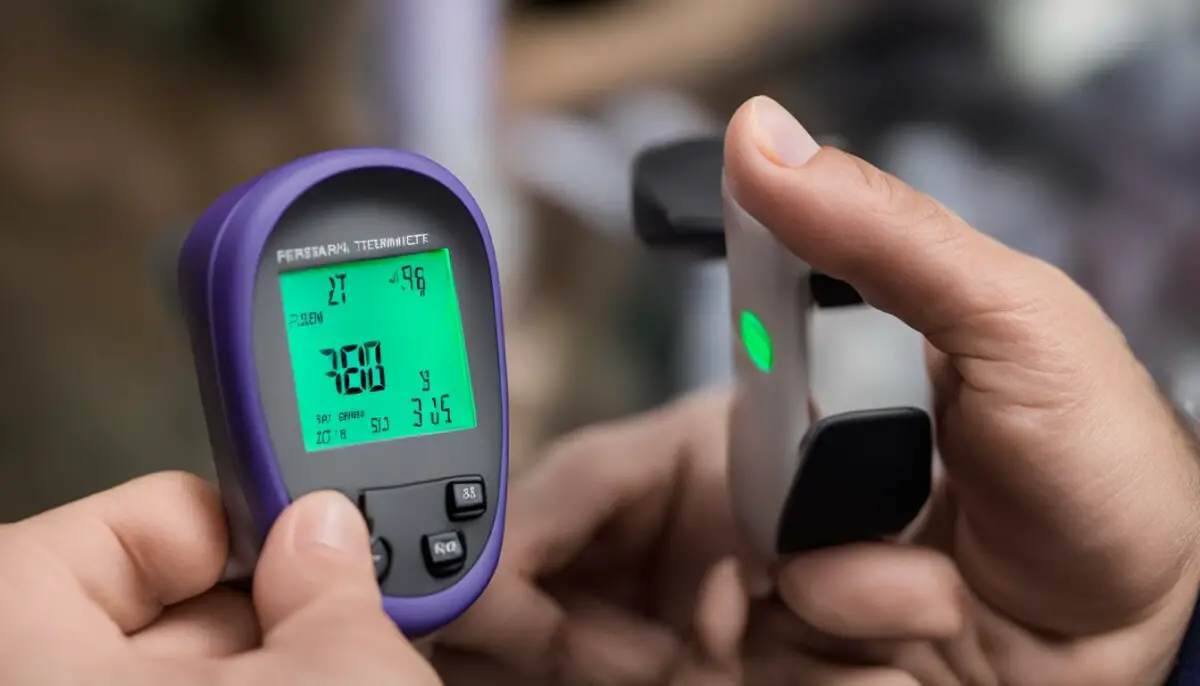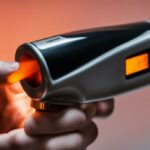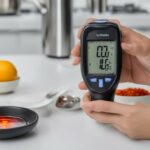Last Updated on 5 months by Francis
If you’re looking for a safe and hygienic way to measure temperature, non contact infrared thermometers are an excellent option. These devices are designed to measure temperature without having to touch the surface being measured, making them perfect for a wide range of applications.
In this guide, we’ll explain how to use a non contact infrared thermometer correctly, outlining the key benefits of this technology and providing step-by-step instructions to achieve accurate temperature readings.
Contents
Key Takeaways
- Non contact infrared thermometers measure temperature without physical contact
- These devices offer several benefits over traditional thermometers including increased hygiene and faster results
- Proper usage is crucial to accurate temperature measurement
- Non contact infrared thermometers are suitable for various environments and applications including medical settings
- Following best practices and guidelines is essential for consistent and accurate measurements
Understanding Non Contact Infrared Thermometer Measurement

Non contact infrared thermometers are commonly used to measure temperature without direct contact between the thermometer and the object being measured. This technology works based on the principle of detecting and measuring the infrared energy emitted by an object. The infrared energy is detected by the thermometer’s sensor, which converts it into an electrical signal that is displayed on the thermometer’s screen.
Understanding the measurement process is crucial for accurate temperature readings. The sensor of the non contact infrared thermometer is pointed towards the object being measured, and the thermometer calculates the temperature based on the amount of infrared energy emitted by the object. The thermometer measures the temperature of a specific spot on the surface of the object, which is called the “spot” or “target” area.
The size of the spot is determined by the distance between the thermometer and the object being measured. The closer the thermometer is to the object, the smaller the spot area will be. Conversely, the further the thermometer is from the object, the larger the spot area will be. It is important to note that the temperature reading is not affected by the size of the spot area, as the thermometer calculates the temperature of the specific spot being measured.
When using a non contact infrared thermometer, it is essential to measure the temperature from the correct distance and angle to ensure accurate and reliable readings. The distance-to-spot ratio (D:S ratio) indicates the distance required to measure the temperature of a particular spot accurately. The larger the D:S ratio, the farther the thermometer should be from the object being measured.
Benefits of Non Contact Infrared Thermometer

Non contact infrared thermometers are becoming increasingly popular among individuals and industries alike. Here are some of the key benefits of using this technology:
| Benefits | Description |
|---|---|
| Faster results | Non contact infrared thermometers can provide accurate temperature readings in a matter of seconds, making them ideal for high-traffic areas or situations where time is of the essence. |
| No contact required | Unlike traditional thermometers, non contact infrared thermometers do not require direct contact with the skin, reducing the risk of cross-contamination and increasing hygiene. |
| Suitable for various environments | Non contact infrared thermometers can be used to measure temperature in a variety of environments, including medical settings, food processing facilities, and industrial workplaces. |
| Easy to use | With a simple point-and-shoot design, non contact infrared thermometers are easy to use even for those without technical expertise. |
| Non-invasive | Non contact infrared thermometers are non-invasive, making them a painless and less stressful alternative for infants and young children who may be afraid of traditional thermometers. |
Overall, non contact infrared thermometers offer a range of benefits over traditional thermometers, making them a popular choice for temperature measurement in various industries and settings.
Non Contact Infrared Thermometer vs Traditional Thermometers
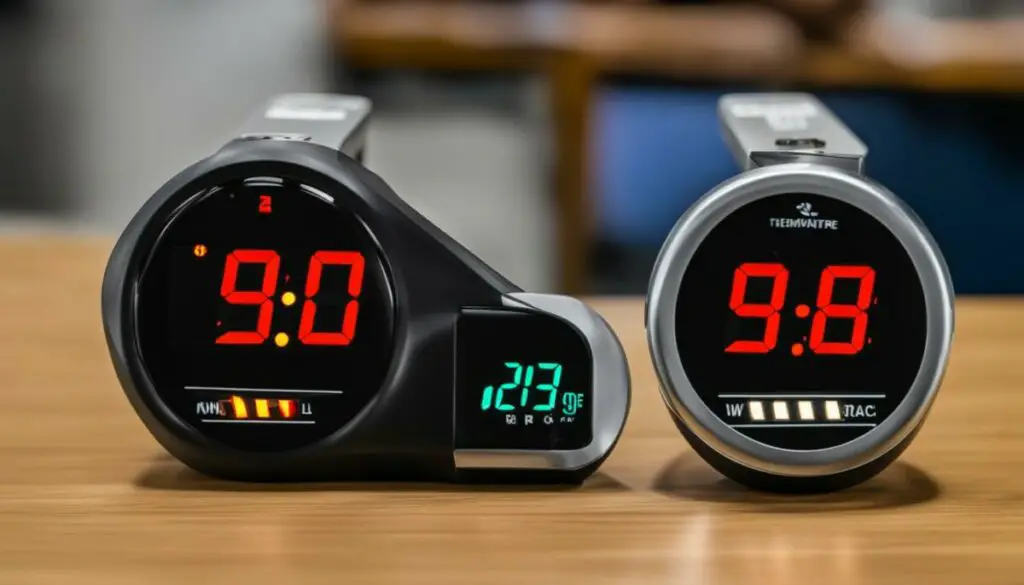
When it comes to measuring temperature, there are two main types of thermometers: traditional and non contact infrared. While both methods can provide accurate readings, there are several key differences between the two that may impact your decision on which to use.
Accuracy
Traditional thermometers typically use mercury or alcohol to measure temperature. While these methods are relatively accurate, they may not be as precise as non contact infrared thermometers.
Non contact infrared thermometers use infrared technology to measure the heat radiating from an object’s surface. This method is highly accurate, as it can detect even small temperature differences. Additionally, non contact infrared thermometers can measure temperature from a distance, making them ideal for measuring the temperature of moving objects or hard-to-reach areas.
Convenience
Traditional thermometers require direct contact with the object being measured, which can be time-consuming and inconvenient. In addition, traditional thermometers may need to be sterilized between uses to prevent cross-contamination.
Non contact infrared thermometers can measure temperature without touching the object, making them faster and more convenient to use. Additionally, non contact infrared thermometers do not require sterilization between uses, as there is no direct contact with the object being measured.
Ease of Use
Traditional thermometers can be difficult to use, especially for children or elderly individuals who may not be able to hold the thermometer in their mouths or under their arms for an extended period of time. In addition, traditional thermometers may be difficult to read, requiring careful observation of the thermometer’s position to accurately determine the temperature.
Non contact infrared thermometers are much easier to use, as they simply need to be pointed at the object being measured. Additionally, non contact infrared thermometers typically provide digital readings, making them easy to read and interpret.
“While both traditional and non contact infrared thermometers can provide accurate temperature readings, non contact infrared thermometers offer increased convenience and ease of use, as well as improved accuracy. “
Proper Usage of Non Contact Infrared Thermometer
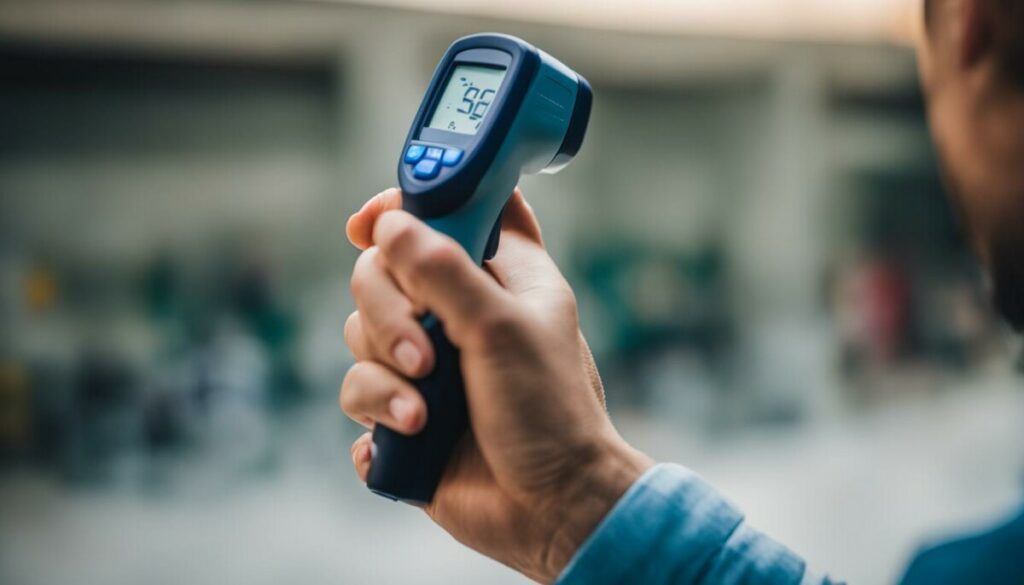
Using a non contact infrared thermometer may appear straightforward, but there are specific steps to follow to ensure accurate and reliable results. Here’s our guide to proper usage:
- Prepare the thermometer: Before taking any measurements, make sure the thermometer is clean and properly calibrated. Follow the manufacturer’s instructions on how to clean your device and how often to calibrate it.
- Prepare the person: Ensure the person being tested is not wearing any headwear or clothing that could interfere with the measurement. Move the hair away from the forehead and ensure the person has not engaged in any activity that could elevate their body temperature, such as exercising or drinking hot liquids.
- Position the thermometer: Hold the thermometer at a distance of about 1-2 inches from the person’s forehead. Make sure the device is pointed directly at the forehead and not at an angle, which could result in an inaccurate reading.
- Take the measurement: Press the button on the thermometer and hold it until you hear a beep. Some thermometers may also have a visual cue to indicate the measurement is complete. Record the temperature reading.
- Interpret the results: Non contact infrared thermometers measure the temperature of the temporal artery on the forehead. The normal temperature reading for adults is between 97.5°F and 99.5°F (36.4°C and 37.5°C). However, temperatures can vary depending on factors such as age and health status, so it’s important to establish a baseline reading for each individual.
Remember: proper usage of a non contact infrared thermometer is essential for accurate readings. Make sure to follow these steps every time you use your device to ensure consistent and reliable measurements.
Common Mistakes to Avoid:
Here are some common mistakes to avoid when using a non contact infrared thermometer:
- Using the device too close or too far from the forehead can result in incorrect readings.
- Not cleaning the device properly can cause inaccurate measurements and spread germs.
- Not calibrating the device regularly can cause inconsistent readings.
- Not following the manufacturer’s instructions can result in incorrect usage and inaccurate results.
By following these guidelines, you can ensure accurate and reliable measurements every time you use your non contact infrared thermometer.
Accurate Measurement with Non Contact Infrared Thermometer
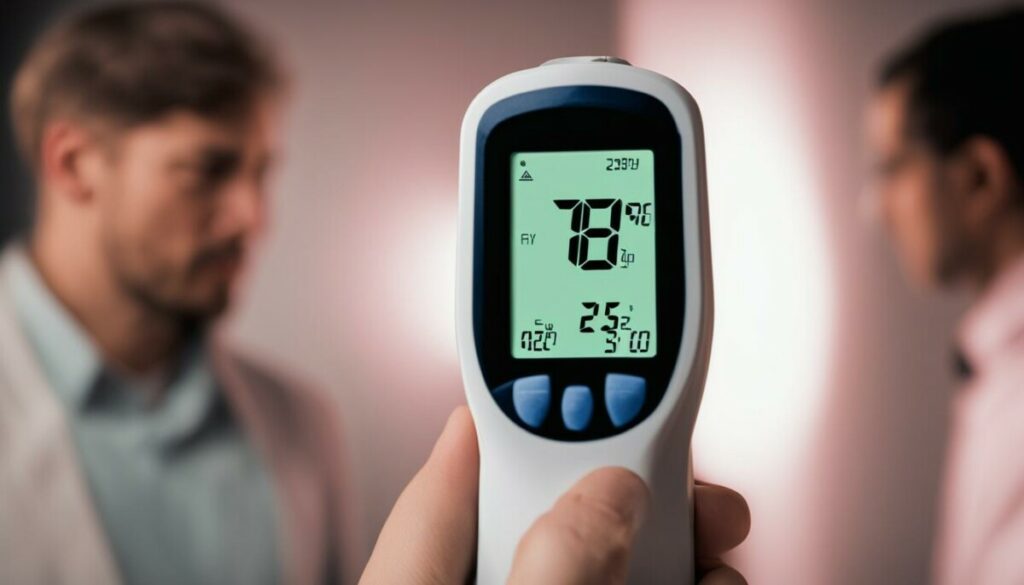
Non contact infrared thermometers are an excellent tool for taking temperature readings without direct contact, but the accuracy of the results can be affected by various factors. By following the proper usage guidelines and taking into account the environmental conditions, you can achieve the most precise measurements.
Factors Affecting Accuracy
The accuracy of non contact infrared thermometer readings can be affected by several factors, including:
| Factor | Effect on Accuracy |
|---|---|
| Distance from Target | The further away from the target, the less accurate the reading |
| Angle of Measurement | The angle at which the thermometer is pointed can affect the reading. Always aim perpendicular to the target |
| Environmental Conditions | Humidity, air temperature, drafts, and other environmental factors can impact measurement accuracy |
Therefore, it is crucial to consider and adjust for these factors when taking measurements to achieve optimal accuracy. Always read the manufacturer’s instructions and guidelines to ensure proper usage and maintenance of the thermometer.
Tips for Accurate Measurements
Here are some additional tips to ensure accurate temperature readings with non contact infrared thermometers:
- Before taking a measurement, make sure the thermometer is calibrated properly. Check the user manual for instructions on calibration.
- Ensure the target area is clean and dry, as moisture or debris can affect the reading.
- Avoid taking measurements through glass or other reflective surfaces, as they can interfere with the accuracy of the reading.
- Always take multiple readings and average them for more accurate results.
- Keep the thermometer sensor and lens clean to ensure accurate measurements. Use a soft cloth or cotton swab to clean them.
By following these tips and considering the environmental factors, you can ensure that your non contact infrared thermometer provides accurate and reliable temperature readings every time.
Advantages of Non Contact Infrared Thermometer
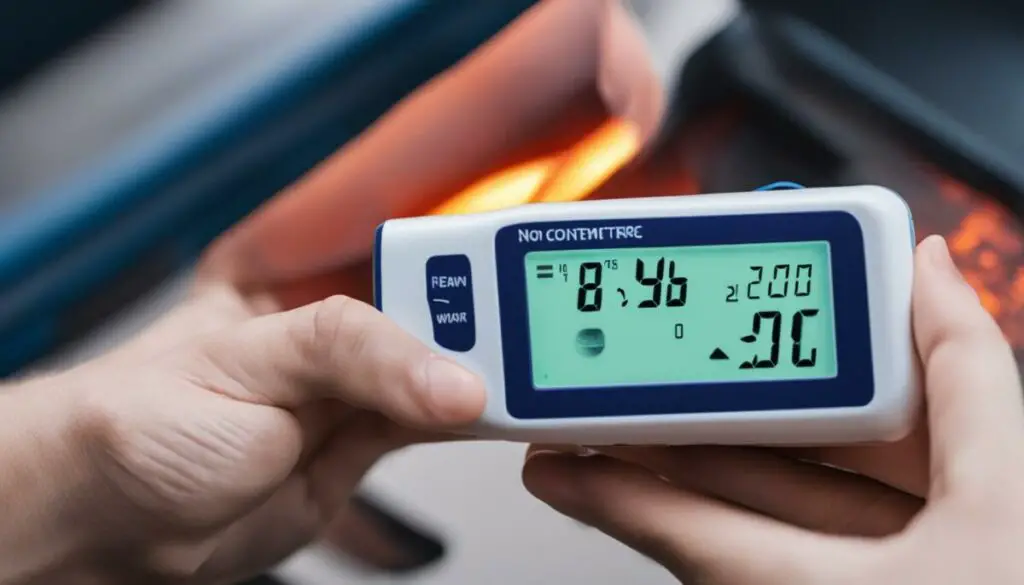
Non contact infrared thermometers have become increasingly popular due to their numerous benefits. Here are some advantages of using non contact infrared thermometers:
| Advantages | Description |
|---|---|
| Faster results | Non contact infrared thermometers provide temperature readings almost instantaneously, making them an ideal choice for busy environments such as hospitals and airports. |
| Increased hygiene | One of the main advantages of non contact infrared thermometers is that they do not require direct contact with the person being tested, reducing the risk of cross-contamination and the spread of infectious diseases. |
| Convenient and easy to use | Non contact infrared thermometers are simple to use and require minimal training. They are also user-friendly and do not cause any discomfort to the person being tested. |
| Non-invasive | Non contact infrared thermometers do not require any bodily fluids or tissue samples, making them a less invasive method of measuring body temperature. |
| Safe | Non contact infrared thermometers do not emit any harmful radiation and are safe to use on people of all ages. |
The advantages of non contact infrared thermometers make them a preferred choice for many industries, including healthcare, food service, and manufacturing. They are versatile and can be used in a variety of settings, from homes to schools to airports.
Best Practices for Using Non Contact Infrared Thermometer

When using a non contact infrared thermometer, there are some best practices that you should follow to ensure accurate measurements. Here are some tips to help you achieve reliable results every time:
Avoid measuring in extreme conditions
Non contact infrared thermometers are designed to measure within a certain range of temperatures, typically between -50°C and 500°C. However, extreme cold or heat can affect the accuracy of the device. Avoid measuring in direct sunlight or in areas with strong air currents, as these can also affect the readings.
Make sure the target is clean and dry
Before taking a measurement, ensure that the surface of the target is clean and dry. Avoid measuring over reflective surfaces, such as glass or polished metal, as these can interfere with the readings.
Hold the thermometer at the correct distance
The distance between the thermometer and the target can affect the accuracy of the readings. Check the manufacturer’s instructions for the recommended distance and hold the thermometer steady at that distance while taking the measurement.
Avoid measuring through obstructions
Non contact infrared thermometers measure the temperature of the surface they are aimed at, so it’s important to avoid measuring through obstructions like glass, plastic or hair.
Calibrate the device regularly
Over time, non contact infrared thermometers can become less accurate due to wear and tear. Calibrate the device regularly to ensure that it is providing reliable readings.
By following these best practices, you can ensure that you get accurate and reliable temperature measurements with your non contact infrared thermometer. Now that you know how to use it properly, you can take advantage of the many benefits this technology has to offer.
Non Contact Infrared Thermometer for Medical Use
Non contact infrared thermometers play a vital role in the medical field, where maintaining hygiene and preventing cross-contamination is of utmost importance. These thermometers enable healthcare professionals to measure the temperature of a patient without direct contact and minimize the risk of infection transmission.
One significant benefit of using non contact infrared thermometers in healthcare settings is that they provide fast and accurate temperature readings, allowing medical professionals to make informed decisions quickly. These thermometers are also easy to use and require minimal training, making them an ideal choice for a busy medical environment.
The non-invasive nature of these thermometers means they are well-suited for monitoring patients in isolation, where direct contact with the patient poses a risk. They can also be used to measure the temperature of patients who are sleeping or unconscious, without disturbing their rest.
Non contact infrared thermometers are versatile and can be used in various medical settings, from hospitals and clinics to nursing homes and hospices. They provide a hygienic and reliable way to measure patient temperature, contributing to the overall safety and well-being of patients and healthcare professionals alike.
Best Practices for Using Non Contact Infrared Thermometers in Medical Settings
When using non contact infrared thermometers in medical settings, it is essential to follow proper usage guidelines to ensure accurate readings and prevent contamination. Here are some best practices to keep in mind:
- Ensure the thermometer is clean and disinfected before each use.
- Position the thermometer to face the center of the forehead, approximately 1-2 inches away.
- Avoid measuring temperature over wounds, abrasions, or other damaged skin areas.
- Take multiple measurements to ensure accuracy and consistency, and record the highest reading.
- Store the thermometer in a clean and dry place after use.
By following these best practices, medical professionals can effectively use non contact infrared thermometers to maintain hygiene and prevent the spread of infections.
Detailed Guide on How to Use Non Contact Infrared Thermometer
Non-contact infrared thermometers are widely used for measuring body temperature without making contact with the skin. Here’s a step-by-step guide on how to use a non-contact infrared thermometer:
- Turn on the thermometer and point it towards the individual’s forehead from a distance of about 1-5 cm.
- Press the measurement button to activate the device, and hold it down as you move the thermometer over the person’s forehead, aiming for the center of the forehead.
- The device will beep or vibrate when it has finished taking the temperature measurement, usually within seconds.
- Record the temperature reading, which should be displayed on the thermometer’s screen. Make sure to note the date and time of measurement for future reference.
- After use, clean the thermometer with a soft cloth or cotton swab soaked in alcohol. Avoid getting the device wet or exposing it to extreme temperatures.
It’s essential to hold the thermometer still and in the correct position during the measurement to ensure accurate results. For more precise readings, it’s recommended to take the temperature in the same spot on the forehead consistently. Avoid measuring temperature in areas with sweat or other debris, such as hats or hair.
Remember, non-contact infrared thermometers aren’t suitable for measuring internal body temperature, and any unusually high readings should be confirmed with a medical professional.
Using a non-contact infrared thermometer is simple and can be an effective way of measuring temperature without making contact with the skin, making it ideal for large crowds and children. Follow these simple steps, and you’ll be able to use a non-contact infrared thermometer with ease.
Ensuring Accurate Readings Every Time
Using a non contact infrared thermometer may seem simple, but ensuring accurate readings every time requires careful attention and adherence to best practices. By following the proper technique, you can achieve precise and reliable temperature measurements for a variety of applications.
First and foremost, it’s crucial to prepare the thermometer for use by following the manufacturer’s instructions. This may involve inserting batteries, powering on the device, or selecting the appropriate mode for the intended use.
Once the thermometer is ready, it’s important to position it correctly for optimal measurement. Hold the device roughly 1-2 inches away from the object or person’s forehead, aiming at the center of the forehead and avoiding any obstructions such as hair or clothing.
Make sure to maintain a steady distance and aim, pressing the trigger to initiate the measurement and holding it until the device emits a beep or other indication that the reading is complete. Be sure to record the temperature reading and take note of any relevant environmental factors that may influence the measurement.
It’s also important to regularly clean and maintain the thermometer to ensure accurate readings over time. Use a soft, damp cloth to wipe down the device after each use, being careful not to scratch or damage the lens or other components.
By following these best practices and remaining mindful of potential sources of error, you can ensure accurate readings every time with your non contact infrared thermometer.
Conclusion
Non contact infrared thermometers are a reliable and convenient way to measure temperature without physical contact. By utilizing the latest technology, they offer numerous benefits over traditional thermometers, including faster results and increased hygiene.
When using a non contact infrared thermometer, it is important to follow proper usage guidelines to ensure accurate readings every time. By understanding the principles behind the measurement and using best practices, you can achieve precise and reliable results with ease.
In medical settings, non contact infrared thermometers play a vital role in maintaining hygiene and preventing the spread of germs. Their suitability for various environments makes them a versatile tool for checking temperatures in different situations.
Overall, non contact infrared thermometers are an essential tool for anyone who needs to measure temperature quickly and accurately. By following the detailed guide provided in this article and keeping these best practices in mind, you can confidently use a non contact infrared thermometer to get accurate readings and keep yourself and those around you safe.
FAQ
How does a non contact infrared thermometer measure temperature without direct contact?
Non contact infrared thermometers use infrared technology to detect the heat radiating from an object or person. They measure the infrared energy emitted by the body or object and convert it into a temperature reading.
What are the benefits of using a non contact infrared thermometer?
Non contact infrared thermometers offer several advantages, such as quick results, hygienic measurements, and the ability to measure temperature from a safe distance. They are also suitable for measuring temperature in various environments.
How does a non contact infrared thermometer compare to traditional thermometers?
Non contact infrared thermometers are generally considered to be more convenient and easier to use than traditional thermometers. They provide quick and accurate readings without the need for direct contact with the person or object being measured.
How do I properly use a non contact infrared thermometer?
To use a non contact infrared thermometer, simply point the device towards the person or object being measured and press the measurement button. Ensure that the distance between the thermometer and the target is within the recommended range for accurate readings.
What factors can affect the accuracy of a non contact infrared thermometer?
Factors such as ambient temperature, humidity, and presence of dust or smoke can affect the accuracy of a non contact infrared thermometer. It is important to follow the manufacturer’s guidelines and ensure the thermometer is properly calibrated for accurate measurements.
Are non contact infrared thermometers suitable for medical use?
Yes, non contact infrared thermometers are widely used in the medical field due to their hygienic nature and ability to quickly measure temperature without direct contact. They help prevent cross-contamination and are suitable for use in hospitals, clinics, and other healthcare settings.
What are some best practices for using a non contact infrared thermometer?
Some best practices for using a non contact infrared thermometer include ensuring a clear line of sight to the target, taking multiple readings for accuracy, and following the manufacturer’s guidelines for proper usage and maintenance of the thermometer.
Can a non contact infrared thermometer be used on infants and children?
Yes, non contact infrared thermometers can be used on infants and children. They provide a non-invasive method of taking temperature measurements without causing discomfort or disturbance.
How long does it take to get a temperature reading with a non contact infrared thermometer?
Non contact infrared thermometers provide quick temperature readings, typically within a few seconds. The exact time may vary depending on the model and manufacturer.
Are non contact infrared thermometers accurate for measuring skin temperature?
Non contact infrared thermometers are generally accurate for measuring skin temperature. However, it is important to follow the manufacturer’s guidelines for proper usage and calibration to ensure accurate readings.

